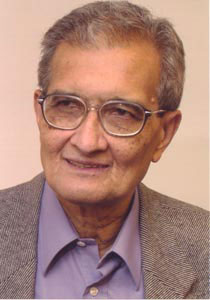Arts
Elegant and Dignified Arguments

The single great gift of Amartya Sen's book The Argumentative Indian is the perfect symbiosis of substance and style.
Amartya Sen, The Argumentative Indian: Writings on Indian History, Culture and Identity (New York: Farrar, Straus and Giroux, October 2005).
In his new book, Amartya Sen argues that Indians come from a long tradition of debate and argumentation. We like to discuss and deliberate. This is not a just a practice about talk or simple chatter, but reasoned reflection about things and issues around us. This tradition, beginning with the Vedas, lives with us, at the core of our tolerance, diversity, richness and even a general diffusiveness. The book on India culture, history and tradition deserves to be read and yes, discussed. Amartya Sen is the winner of the Nobel Prize in economics in 1998, Master of Trinity College, Cambridge, England, from 1998 to 2004, and currently professor at Harvard University. One of the most engaging and intelligent public intellectuals of our time, Amartya Sen is a great defender and advocate of Indian traditions. He presents his case in the most erudite manner. This book is a veritable treasure of references to India’s cultural and historical richness. Its arguments are presented in Sen’s signature gentle manner with little antagonism against anyone, but with powerful insights and advice against narrow-mindedness or beliefs in exclusivity of any kind. Professor Sen emerges as the true “cosmopolitan” citizen of the world, as his colleague Martha Nussbaum would say. There is extreme pride of India, of which he is still a citizen, in his writings, but also a generous worldliness. The book begins with a broad outlook set against the recent fundamentalist views in India about the Hindu religion, its exclusivist claims and fervor against other traditions, native and foreign. There is little, if any, in Indian tradition to support these perspectives. Skepticism and heterodoxy have always been a part of our social life. We merged with what we met and we generated through all those encounters layers of complexity in our lives, argued through, embraced at every level and hardly ever forgotten. The first part of the book, given to explaining this argumentative tradition, is the richest and the newest of Sen’s expositions. While he claims that India has the most voluminous religious literature in the world, he moves on to explain how religiosity is not a feature of the Indian way of life. Indeed, this notion that Indian life is not religious, but practical, moral and discursive works against all the stereotypes the west has harbored for years. The traditions of heterodoxy are not Hindu, since nothing in India is exclusively Hindu. From the great Buddhist traditions nurtured by Emperor Ashok or the secularist patronage of Akbar, the Indian way of life has shown that it can flourish with the practice, not just the preaching, of diversity and that it can work through all this with openness and readiness for certain fluidity in the world. One of the most engaging, intelligent public intellectuals of our time, Amartya Sen is a great defender and advocate of Indian traditions.
We have argued and struggled against the interpretation of India as a domineering culture, that Hinduism gives shelter to a form of thinking that is centralizing and less tolerant. The complete absence of a single logical system in Indian thought troubled every philosopher from Hegel and Nietzsche to more recently Samuel Huntington. The worship of Rama as the singular form of authority, whether in name or in delegation, has its roots in narrow and domineering interpretations of Indian traditions. Reading Bhagvad Gita, one could surmise that Krishna’s authority is singular and total. Arjuna appears in this interpretation as an obedient disciple who listens to his guru in times of trouble. This gives rise to the arrogant authority of the Brahmins and gurus. But then again in India, the Bhakti tradition truly democratizes Gita, taking the idea of interpretation to those who believe and who practice. The heuristic view of India, where plurality is not a faith, but a practice, lies at the heart of this book. Amartya Sen’s sustained exposition of this idea resonates as he moves through India’s heritage in literature, science and mathematics. No other place, he argues, has welcomed and merged various traditions within Hinduism, but also in Islam, Christianity and Buddhism . |


